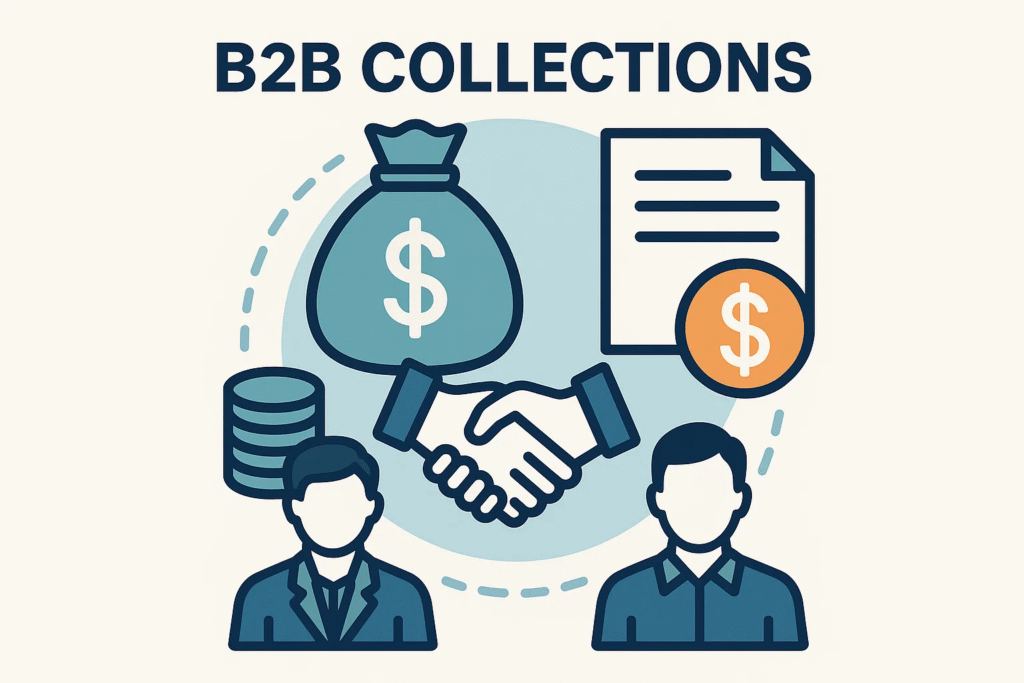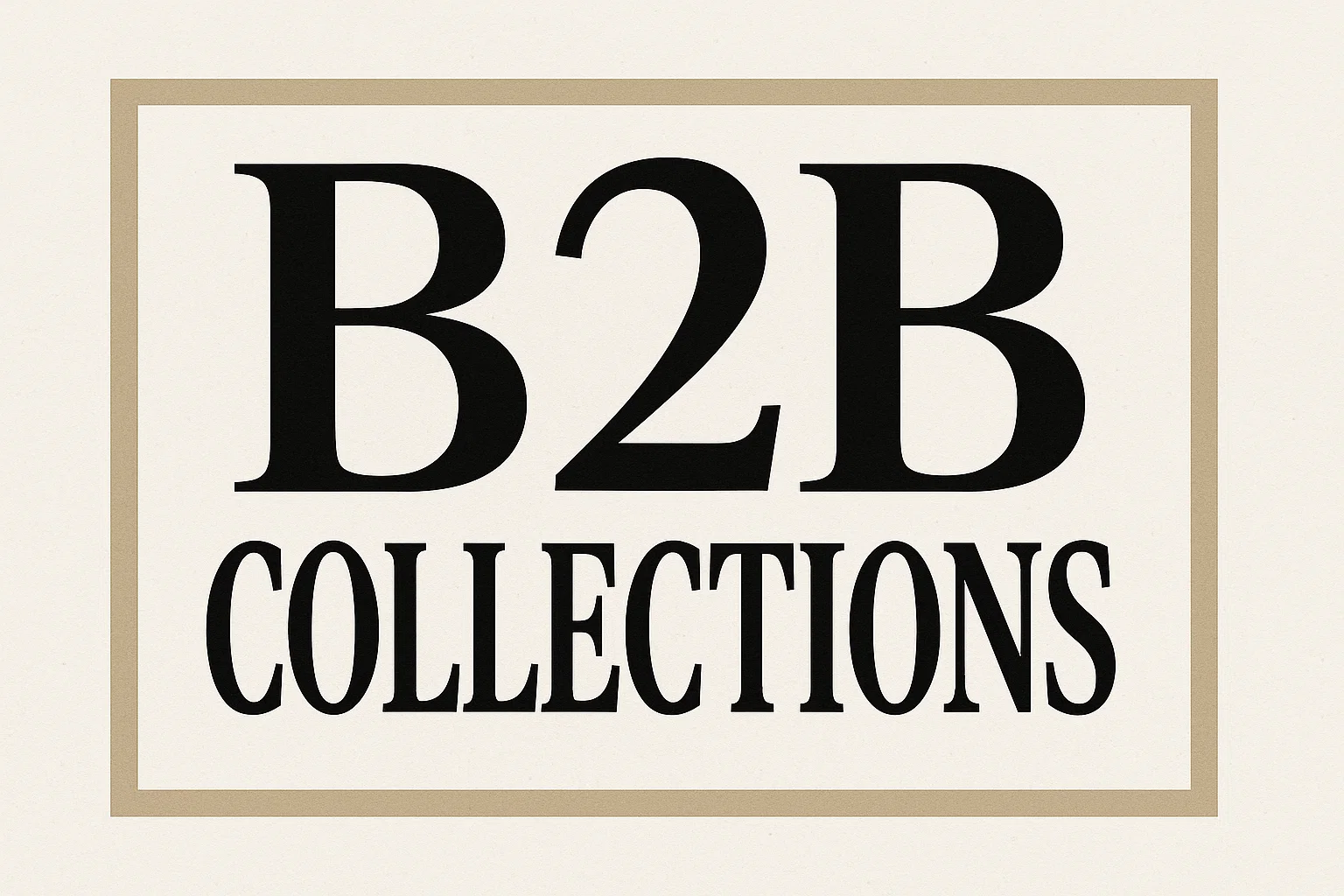introduction to b2b collections
B2B Collections That Work: A Positive Blueprint for Better Cash Flow and Client Trust
B2B collections. Two words that never exactly excite anyone. For most companies, it’s the uncomfortable aspect of conducting business—the behind-the-scenes arm wrestling in order to receive payment. But what if I were to tell you that B2B collections don’t necessarily have to be a battle? That they could actually be an extension of your customer service and professionalism of your brand?

The reality is this: every healthy B2B company needs a smart, human, and proactive collections strategy. It’s not about chasing down cash with a pitchfork. It’s about creating a positive, repeatable system that supports both your business goals and your relationships.
In this article, we’ll explore what effective B2B collections look like in today’s business landscape—based on experience, best practices, and a little bit of hard-earned wisdom.
Understanding Why B2B Collections Matter
Every transaction your business completes, no matter how valuable, becomes a liability if you’re not getting paid. Revenue only becomes reality when cash is in the account. That’s where collections play a crucial role.
Effective B2B collections enable you to have a healthy cash position, finance operations, and grow without the need for credit or guessing. When companies pay late, it not only messes with your accounting—it can undermine payroll, inventory planning, and even your vendor relationships.
Effective collections don’t fix just a financial issue—they give you financial clarity and confidence.
Changing the Narrative Around Collections
Far too many collections are handled like damage control. You wait for something to go wrong, then rush to clean it up. But collections work best when they’re proactive, not reactive.
Think of collections as part of your customer success plan. You’re enforcing responsibility and professionalism—not smoke signals from a sinking ship. When you think about collections this way, you maintain trust rather than stretching it.
Professional follow-ups demonstrate that you value your own work and deserve the same value in return.
Building the Foundation Early
The collections process begins many months before an invoice becomes overdue. It begins with how you bring on clients, organize agreements, and establish expectations. B2B Collections
Begin by having your contracts and sales agreements spell out payment terms, timeframes, and billing contact points clearly. Ensure that your client’s entire team understands who is responsible for payments—and that your team knows who to call if something’s held up. B2B Collections B2B Collections
Clarity upfront is less painful follow-through.
A fast tip: skip the legalese. Focus on clear, simple language. You don’t have to speak like a courtroom clerk to be heard. Just be direct, clear, and accessible.
Crafting Invoices That Do Work
Your invoice is your first collection tool. Treat it like a financial handshake. If it’s cryptic, messy, or opaque, you’re inviting delays.
A neat, well-designed invoice should contain:
A definite due date
An itemized list of products or services
Your payment information for your company
A point of direct contact in the event of problems
Any payment terms or late fee policies that may apply
Speed counts as well. Invoice as quickly as possible once you have finished the work. The longer you delay invoicing, the more you normalize delay—both you and your client.”.
Also, make it easy to pay. Add direct payment links or simple bank transfer instructions. Ease of use can prompt faster action. B2B Collections
Leaning on Automation—With a Human Touch
You do not have to follow up on every invoice personally. It is easy today with the automation tools to automate reminders, monitor payment status, and follow up after a certain interval.
Automation, however, should never supplant empathy.
Automate reminders using tools such as Xero, QuickBooks, or FreshBooks. Couple them with personalized messaging that aligns with your tone and brand voice. You need your client to feel special and individually cared for, not just another task on a list.
Convenience can be its own reward, but you want human connection too. Balance is essential. Automation provides consistency. Personalization brings connection.
Writing Collection Emails That Clients Actually Respond To
Collection emails don’t have to be formal or threatening. Actually, they’re much better received when written in a polite, assertive, and problem-solving tone.
Here’s a good template:
Begin with a positive, friendly greeting
Mention the invoice clearly with information such as date and amount
Request an update or confirmation, rather than payment
Provide help if there’s something holding it back
Thank them in advance for their consideration
You’re not asking, you’re checking in. You’re not pleading, you’re following up. With the right phrasing, these emails don’t push clients away—they nudge them into action.
And in most instances, a nudge is all you need.
Having a Follow-Up Rhythm
Perseverance is great—but it requires a beat. Follow up too frequently, and you run the risk of annoying your client. Wait too long, and you lose your momentum.
Establish a concise internal follow-up schedule according to your payment terms. For example, if payment is expected within 30 days, schedule your contacts at regular intervals before and after that.
Begin with a polite reminder when the deadline is near. If no answer is forthcoming, heighten the urgency slightly in tone and medium. Then, if the lag continues, break out the telephone or bring someone higher in the chain into the loop, such as an account manager or executive sponsor.
With each follow-up, become more explicit but never obnoxious. Courtesy with each step maintains the possibility for ongoing business when the glitch is solved.
Monitoring Client Payment Behavior
Clients are not all created equal—at least, not when it comes to timely payment. That’s why monitoring and analyzing client payment behavior over time is so valuable.
Track:
Average number of days that invoices are past due
Frequency of follow-up that you need to make
Whether excuses or disputes are a recurring pattern
Response to your follow-up
This allows you to segment customers by risk. For trustworthy customers, you can stay with regular terms. For high-risk or repeat violators, try demanding part payment in advance or modifying their terms completely.
Payment information is a tool for business intelligence. Take advantage of it.
The Psychology Behind Payment Excuses
Nearly every AR staff has overheard some iteration of the following:
“We never received the invoice.”
“Our AP individual is away.”
“It’s in the department for approval.”
“We’re putting it through shortly.”
Sound familiar? You’re not alone.
Rather than getting frustrated, focus on response strategies. Confirm contact details. Offer to resend. Ask when the person in charge will return or if there’s a backup. In some cases, asking for a firm date is enough to get things moving.
Excuses are often signs of disorganization rather than malice. Handle them with patience, but don’t let them become habits.
Charging Late Fees: Yes or No?
Late charges are a hot-button issue in B2B communities. To charge them or not to charge them? Do they reinforce or damage the relationship?
Here’s a fair perspective.
Make provision for a late charge policy in your contracts and bills, even if you infrequently apply it. This sends the message that you respect timely payment and are willing to take action if need be.
Exercise discretion in charging fees. One missed payment by a normally prompt client might warrant a friendly reminder. But if a client is consistently late without explanation, fees can act as a reminder about standards.
It’s not punishing—It’s signaling standards.
When to Take It Up a Level
At some point, if the bill is unpaid and untouched, escalation is required. B2B Collections
This could entail:
Notifying your legal team
Involving senior management
Hiring a third-party collections agency
Escalation is not revenge. It’s resolution. And it should only be used as a last resort. The best collections escalate elegantly, with an eye towards maintaining the future relationship if at all possible.
Document everything. Keep messages factual and professional. If there’s a need for legal action, clarity and records will be your friends.
Building Relationships While Collecting
Ironically, at times collections can bring you closer to your customers.
If treated with care, your professionalism and patience can win them over. You can reveal internal process problems they weren’t aware of or spot communication break downs within their team.
Take the time to remind them of your trustworthiness and commitment to partnership. Propose means of simplifying future billing. Provide solutions rather than threats.
Such an approach actually serves to boost loyalty, particularly when clients feel supported rather than pressured.
Creating a Scalable Collections System
As your business expands, you require a collections process that expands with you. That translates to consistency, automation, and cross-team visibility. B2B Collections
Establish a collections playbook that consists of: B2B Collections
Standard email templates and timing
Escalation procedures that are clearly defined
Integration of CRM or ERP system
A client risk-rating system
Get your sales, account management, and finance teams trained to collaborate. Collections is not solely a back-office issue—confront it as a full-business process. Payment histories need to be known by sales. AR issues need to be known by account managers. Communication improves when everybody wins.
Why Good Collections = Stronger Business Health
B2B collections are more than recovering revenue. They’re about developing an accountability and respect culture—internally and externally.
With an ongoing collections process, your company has:
Regular cash flow
Fewer operational headaches
Improved planning capabilities B2B Collections
More robust relationships founded on transparency
Timely-paying clients are more likely to remain. Your staff can concentrate on expansion, not on chasing funds. And your company can act from a place of financial fortitude, not need. B2B Collections
Collections become a strategic strength—not simply a necessary evil.
Final Thoughts: Leading with Confidence and Clarity
If you’ve ever dreaded requesting payment, keep this in mind: you’re not being rude. You’re living up to your side of a professional deal. The value has been transferred. The invoice is an expression of that.
When you go into collections with confidence, consistency, and concern, you establish your business as trustworthy, reliable, and fair.
That reputation is valuable.
Customers respect companies who establish clear expectations and maintain them. And when there are problems, they’re more likely to cooperate with you in coming up with a solution if you’ve respected them in the process. B2B Collections
So reframe the way you think about collections. They’re not a battle. They’re a dialogue. They’re not an obstacle. They’re a testament to how seriously your company is about itself—and how determined you are to make every relationship successful. B2B Collections





